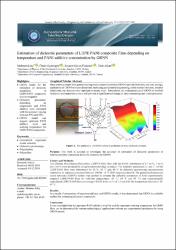DYPE/PANI kompozit filmlerin sıcaklığa ve PANI katkı konsantrasyonuna bağlı olarak dielektrik parametrelerinin GRSA ile tahmini
Özet
Bu çalışmada, düşük yoğunluklu polietilenin (DYPE) kompleks dielektrik fonksiyonunun gerçek ve sanal
bileşenlerinin ( ve ) hem polianilin (PANI) katkısına hem de sıcaklığa bağlı değişimlerinin,
genelleştirilmiş regrasyon sinir ağları (GRSA) metoduyla yüksek doğrulukla tahmin edilebileceği
gösterilmiştir. Bunun için öncelikle, saf DYPE ve kütlece % 0,7, %1 ve %3 PANI katkılandırılmış
DYPE/PANI kompozitler fimler hazırlanmış ve ilgili numunelerin 20℃, 50℃ ve 80℃’de ve
bileşenlerinin frekansa bağlı değişimleri dielektrik spektroskopisi yöntemiyle deneysel olarak belirlenmiştir.
Ardından, dielektrik parametrelerin tahmin değerlerine karşılık gerçek değerlerine göre çizilen grafikler
yardımıyla, GRSA modelinin ilgili parametrelerin tayinindeki başarı performansı R 0,9998 ve R 0,9365
olarak tespit edilmiştir. Bu noktadan hareketle, GRSA modeli önce mevcut numunelerin 35℃, 65℃ ve 95℃
sıcaklıklarda frekansa bağlı olarak ve bileşenlerinin değişimini tahmin etmekte kullanılmıştır.
Ardından, deneysel olarak hiç üretilmemiş iki faklı kompozit için (%1,5 ve %6 PANI katkılı DYPE) 20℃,
35℃, 50℃, 65℃, 80℃ ve 95℃’de ve bileşenlerinin frekansa bağlı değişimleri GRSA metodu ile
önerilmiştir. Böylece, deneysel olarak üretilmeyen bu numunelerin sıcaklığa ve frekansa bağlı dielektrik
parametreleri belirlenmiştir. In this study, it has been shown that the variation of the real and imaginary components of the complex
dielectric function of low density polyethylene (LDPE) with both the polyaniline (PANI) additive and
temperature can be predicted with high accuracy by generalized regression neural networks (GRNN) method.
First of all, pure LDPE and 0.7 wt.%, 1 wt.% and 3 wt.% PANI doped LDPE/PANI composites were prepared
and the variations of and components of the samples with frequency were determined at 20℃, 50℃
and 80℃ by dielectric spectroscopy. Then, with the help of the actual values versus predicted values of the
dielectric parameters graphics, the success performance of the GRNN model for determining the related
parameters was determined as R 0.9998 and R 0.9365 . From this point, the GRNN model was first used
to estimate the variation of the and components with respect to frequency at 35℃, 65℃ and 95℃ for
the existing samples. Then, the variations of the and components with frequency of the two composites
(1.5 % and 6 %PANI doped LDPE), which were not produced experimentally, were proposed at 35℃, 50℃,
65℃, 80℃ and 95℃ by GRNN model. Thus, the dielectric parameters depending on the temperature and
frequency for these samples, which have not been produced experimentally, were determined.
Cilt
35Sayı
2Bağlantı
https://hdl.handle.net/11363/6234Koleksiyonlar
Aşağıdaki lisans dosyası bu öğe ile ilişkilidir:


















